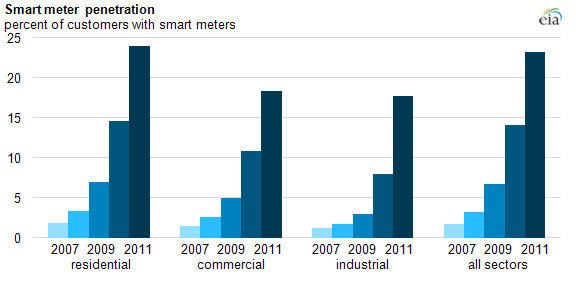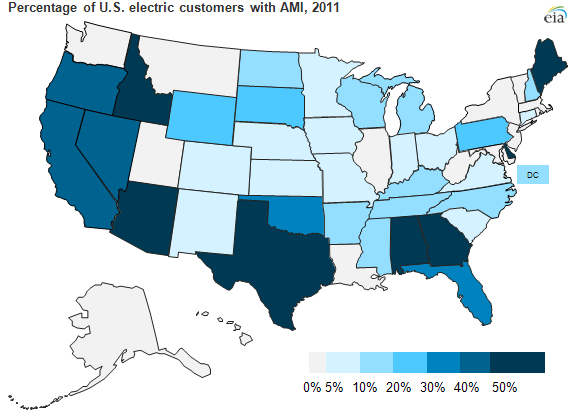
Smart meter deployments continue to rise

Electric meters with enhanced communication capabilities—an essential component of the smart grid—are becoming more prevalent. In 2011, more than 23% of all U.S. electrical customers had smart meters. These meters use two-way communication to connect utilities and their customers. They support demand response and distributed generation, can improve reliability, and also provide information that consumers can use to save money by managing their use of electricity.
At the end of 2011, more than 33 million U.S. customers had smart meters. So far in 2012, progress has continued, with nearly three million additional smart meter installations reported to EIA between January and August.
Smart meters, or advanced metering infrastructure (AMI), can take real-time or near-real-time measurements, provide outage notification and power quality monitoring, and support in-home energy applications. The general term "advanced meters" includes meters with one-way, meter-to-utility communication (called automated meter reading, or AMR). In 2011, the count of AMR meters decreased for the first time.
Utilities have incentives to install advanced meters for residential customers because automated meter reading and remote connect-disconnect options can help lower costs. Further, revenue for regulated utilities is tied in part to capital investments. At a time when major outlays for new electric generators are fairly low, other infrastructure investments like smart meters become important revenue sources.
When combined with automated data analysis, AMI data can provide the utility with detailed outage information in the event of a storm or other system disturbance. This information helps the utility restore service to customers more quickly and reduces the overall length of electric system outages. In a recent example, a tree limb fell onto a power line, knocking out power to 1,100 customers. Smart meter data allowed the utility to reroute power to all but 200 customers in less than one minute.
While advanced meters have some immediate benefits to the utility and reliability, much of the potential for consumers requires additional components or options. AMI capability, when combined with real-time prices and time-of-day or other pricing options, gives consumers the information they need to shift their energy use to times of day when energy prices are lower. Better information makes it easier for consumers to turn their AMI data into action through third parties and apps. Customers who can manage their energy use effectively can save money and conserve energy, all of which can contribute to reduced need for additional power plants.
Despite these benefits, there are concerns about smart meters, including unresolved data privacy and data security issues. In addition, the net benefits of this technology to consumers remain unproven. Such concerns have resulted in moratoria or other delays on smart meter rollouts, as well as opt-out programs that allow customers to be excluded from a smart meter rollout, typically for a fee. Recently, however, utilities in Oregon, Maine, and California reported that only very small numbers of customers are opting out of smart-meter programs.
Smart meter penetration rates vary widely by state. The 2011 national average penetration rate was more than 23%, while rates in 13 states exceeded 25%, with Maine topping the list with an AMI penetration rate of 84%. Only West Virginia reported no AMI installations in 2011, although it did report having some one-way meters. These state differences are driven by state legislation and regulation (cost recovery for metering projects typically must be approved by state utility regulators). The Association for Demand Response and Smart Grid publishes a report on state-level actions on advanced metering, among other topics.

Commercial and industrial customers probably have lower penetration rates for these digital meters because they are more likely to have more sophisticated analog meters already installed, consistent with being on time-of-use or interruptible tariffs.
Tags: electricity, map, smart grid, states